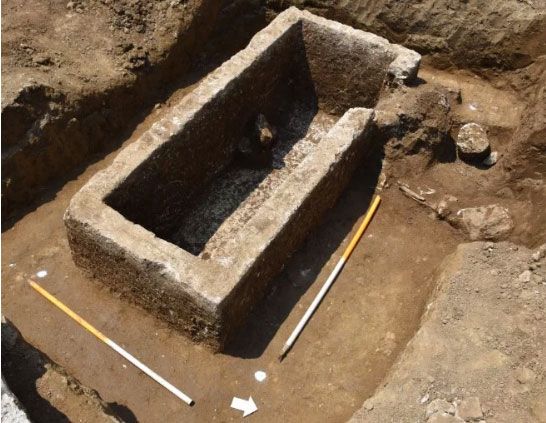 BELGRADE, SERBIA—Roman tombs dated to the third and fourth centuries A.D. and about 200 feet of lead pipe from a Roman aqueduct have been uncovered in the center of the city of Belgrade, according to a Live Science report. Known as Singidunum, the ancient settlement was a seat of Roman military power that was granted city status by the emperor Hadrian, who ruled from A.D. 117 to 138. Archaeologist Milorad Ignjatović of the Belgrade City Museum explained that two of the 14 tombs have rectangular bases with arched vaults walled with bricks, while two others were made with bricks stacked in a shape resembling a coffin. Four stone sarcophagi have also been found, he added. Most of the tombs had been looted, but researchers did recover parts of a gold necklace and a glass hairpin. The excavation, which is being conducted ahead of the construction of a parking garage, has also revealed the remains of an Ottoman settlement dated to the seventeenth and eighteenth centuries, and the ruins of buildings bombed by Allied forces in the twentieth century, at the end of World War II. To read about a Roman ship unearthed in a Serbian strip mine, go to "Roman River Cruiser."
BELGRADE, SERBIA—Roman tombs dated to the third and fourth centuries A.D. and about 200 feet of lead pipe from a Roman aqueduct have been uncovered in the center of the city of Belgrade, according to a Live Science report. Known as Singidunum, the ancient settlement was a seat of Roman military power that was granted city status by the emperor Hadrian, who ruled from A.D. 117 to 138. Archaeologist Milorad Ignjatović of the Belgrade City Museum explained that two of the 14 tombs have rectangular bases with arched vaults walled with bricks, while two others were made with bricks stacked in a shape resembling a coffin. Four stone sarcophagi have also been found, he added. Most of the tombs had been looted, but researchers did recover parts of a gold necklace and a glass hairpin. The excavation, which is being conducted ahead of the construction of a parking garage, has also revealed the remains of an Ottoman settlement dated to the seventeenth and eighteenth centuries, and the ruins of buildings bombed by Allied forces in the twentieth century, at the end of World War II. To read about a Roman ship unearthed in a Serbian strip mine, go to "Roman River Cruiser."
Roman Tombs and Aqueduct Uncovered in Serbia
